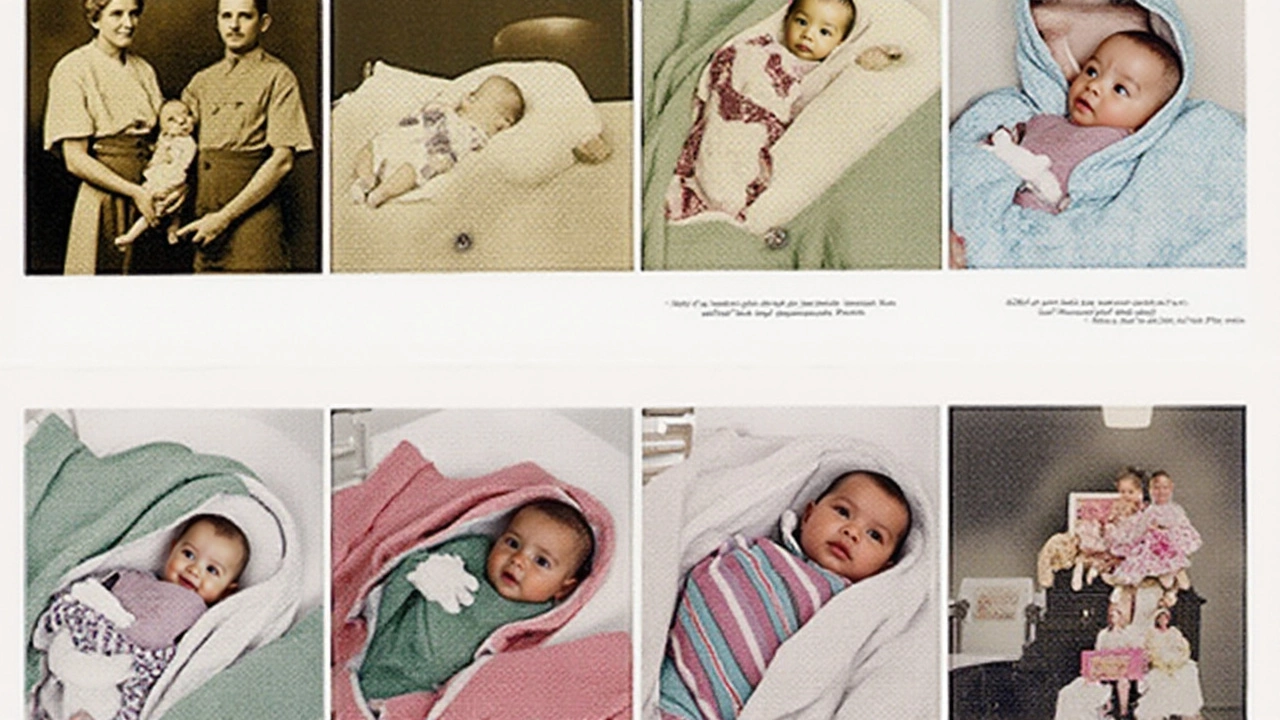Why Hospital Baby Blankets Haven't Changed for Decades and Their Significance

Peek into any nursery room in a hospital, and one sight is near-universal: the soft, yet distinctively rough baby blanket interwoven with blue and pink stripes. These blankets, more than any other nursery item, have become symbols of the first moments of life. Ever wondered why these baby blankets all look the same, or why their design has barely shifted over decades?
From their origins to their steadfast relationship with new parents, the journey of the hospital baby blanket is a tale woven as richly as its fabric. Their continuous popularity is backed by more than mere tradition; both utility and nostalgia play vital roles in their evergreen presence. Let's journey through the past and the present of these seemingly humble textiles, revealing both history and hidden truths.
- The History of Hospital Baby Blankets
- Design and Functionality
- Symbolism and Cultural Impact
- Modern Alternatives and Sustainability
The History of Hospital Baby Blankets
The story of hospital baby blankets, with their familiar pastel-striped motif, is rooted in practicality as much as tradition. The ubiquitous blankets, sometimes called Kuddle-Up blankets, are primarily manufactured by Medline Industries. Their introduction in hospital settings dates back to the 1950s, a period marked by heightened industrialization and a burgeoning healthcare system. Hospitals of that era were bustling places that required efficient, hygienic, and cost-effective solutions for infant care, and the versatile baby blanket proved a timeless solution.
The choice of colors—typically blue and pink stripes—reflects accessibility and standardization. These blankets use a blend of cotton and acrylic fibers, offering durability while being soft enough for a newborn’s delicate skin. The blue and pink striped pattern was initially chosen because it is cost-effective and gender-neutral while still appealing to the traditional color associations for boys and girls. The very simplicity of this design means it never goes out of style, allowing them to transition easily between decades.
Over time, these baby blanket designs found roots in hospitals across the United States, and have barely shifted since their inception, speaking to their ingenious utility. In fact, hospitals, faced with tight budgets, found these blankets a cost-saving alternative to more detailed textiles. They are easily stackable, machine washable at high temperatures for infection control, and incredibly durable. This consistency has created a form of cultural imprint, instilling a sense of nostalgia and reliability among generations of parents.
The evolution of hospital blankets is a testament to the intersection of practicality and social meaning. As Dr. Angie Willy, a historian of medical textiles, notes,
"Hospital baby blankets capture the soul of simplicity and efficiency. They are among the first touches of warmth and familiarity for newborns—like a consistent background score to the first breaths."
Preserving the symbolic and practical elements, these blankets highlight the role of early childhood healthcare in the wider narrative of social history. They speak to the continuity of care from the mid-20th century to now, embodying a quiet certitude in maternal infant care while adapting steadily to modern sustainability concerns.

Design and Functionality
The design of the ubiquitous hospital baby blankets is no accident of history; it has evolved intentionally to meet the needs of both the medical staff and the newborns they cradle. Known for their practical and simple blue and pink pinstripes, these blankets are produced from a specialized blend of cotton and acrylic, a combination which ensures durability and softness at the same time. The particular weave structure employed helps the blankets withstand industrial laundering processes without losing their form or texture, a practical necessity given their widespread daily use in healthcare facilities.
Parents and nurses alike appreciate that these blankets provide warmth without overheating the infant, thanks to their breathable fiber composition. Not too thick yet not flimsy, the design prioritizes the baby's comfort while allowing caregivers to easily perform essential tasks like swaddling and handling. Baby blanket design isn't just about aesthetics; it's about enhancing the caregiving experience. Dr. Sarah Mitchell, a pediatric care expert, once noted,
"The consistency in hospital baby blankets allows for a reliable first layer of comfort and security that is crucial in the immediate postpartum experience."
This simple design, however, also carries with it a significant cultural and emotional weight. Its understated appearance, coupled with iconic stripe colors, means that it has transformed into an emblem of new beginnings, instantly recognizable and universally beloved. Another practical aspect lies in the fact that these blankets are inexpensive to produce, allowing hospitals to maintain ample stocks. This ensures they always have fresh ones available, never compromising hygiene and safety standards. The standard stripe pattern helps in hiding stains and marks that might occur during use, which is a clever yet overlooked aspect of their functionality.
For those considering modern alternatives to these blankets, it is essential to recognize the balance they strike between functionality and comfort. Many potential substitutions exist, ranging from high-end cotton versions to eco-friendly options made from bamboo fibers. However, the reliability of traditional hospital textiles remains unmatched, often making them the preferred choice for medical institutions. Whether you are a designer looking to innovate, a parent stocking up on essentials, or simply curious, understanding the humble yet sophisticated design of the hospital baby blanket can provide insights into why it endures as a favorite even in modern times.

Symbolism and Cultural Impact
It's intriguing how a simple piece of woven fabric has grown to hold such a deep emotional grip over people. The standard hospital baby blankets, with their pink and blue stripes, have emerged as the quintessential emblem of new beginnings. In many households, these blankets are cherished and carefully preserved, sometimes even passed down through generations as keepsakes. The consistent use of these blankets in hospitals across the United States has transformed them from mere functional items into powerful symbols of birth and nurturing.
Over the decades, the blanket has become synonymous with the concept of newborn care, securing its place in family photo albums and baby announcement cards. It’s more than a practical swaddle; it’s an heirloom item that greets family members and friends, sharing the news of a new arrival. This role has been solidified not just through its omnipresence in hospitals, but through portrayals in media. The striped blanket, as seen in countless baby photos, advertisements, and films, has etched itself into the collective consciousness, providing a comforting sense of familiarity and authenticity.
While the blanket’s design is minimalist, the gender-neutral colors carry their own symbolism. Pink and blue stripes are a gentle nod to gender traditions, yet they are balanced perfectly to avoid favoring one over the other, making each blanket a universal item, uniting babies of all backgrounds under the same cozy emblem. The symbolism extends beyond gender neutrality and also ties to broader concepts such as simplicity, safety, and initial warmth in a new unfamiliar world. This makes them a poignant reminder of both the fragility and potential of new life.
According to Dr. Emily Collins, a respected pediatrician, 'The blankets aren’t just about temperature. They offer a sense of continuity and reassurance to both parents and medical staff, knowing that each new life starts wrapped in these threads.'
Beyond their emotional impact, these blankets have also become cultural touchstones. It is common for parents across the country to post pictures of their newborns swaddled in that recognizable pattern with pride and a flash of nostalgia. However, in the arena of discussions concerning cultural appropriation and diversity, the uniform design of these blankets also creates grounds for debates on inclusivity within healthcare systems. Despite their commonality, the tradition supports a sense of shared humanity and egalitarianism—every child, regardless of background, receives the same first embrace. This potential for unity may be another reason their design has remained largely unchanged.
No exploration of the baby blanket design is complete without acknowledging how it impacts family rituals. These blankets often feature in key moments beyond the hospital — from the baby’s ride home, their sleeping quarters in the nursery, to framing their tiny faces in countless first portraits. Their presence encapsulates the hopes and dreams awaiting every newborn, and the joy and responsibility they bring. Lovers of symbolism might see the stripes representing the journey of life, marking transitions and hopes. For many, the sight of these blankets is a continual reminder of shared human experiences, where life’s beginnings and endearments are experienced communally.

Modern Alternatives and Sustainability
In recent years, as society has become more environmentally conscious, the acceptable norms surrounding hospital baby blankets have evolved. While the traditional cotton blend blankets remain prevalent, there is a growing interest in more sustainable fabrics and practices within hospitals. Hospital baby blankets have started to see competition from modern alternatives that focus on reducing the ecological footprint. Options made from organic cotton, bamboo fibers, or recycled materials are gaining popularity among healthcare providers keen on sustainability.
The charm of these eco-friendly alternatives lies not only in their reduced environmental impact but also in their innovative manufacturing processes. Organic cotton, for instance, avoids the use of harmful chemicals and pesticides, making it gentler for babies' sensitive skin. Bamboo fiber blankets offer the added benefits of being highly renewable, naturally antibacterial, and hypoallergenic. These characteristics make bamboo an attractive option for a new generation of parents and hospitals committed to the wellbeing of both neonates and the planet.
In the quest for sustainability, some hospitals and parents have embraced recycled fabrics, which leverage textile waste to produce soft, durable blankets. The recycling process preserves resources and reduces the load on landfills, contributing to a healthier planet.
"Recycled textile products can reduce energy consumption by up to 50% compared to the production of virgin materials," according to Green America, an advocacy group committed to sustainable commerce.One poignant example is the production of hospital blankets from post-consumer plastic bottles, demonstrating innovative steps towards a circular economy.
As these modern alternatives gain traction, they are beginning to influence large-scale procurement decisions within hospitals. Health facilities adopting green textiles often find themselves part of broader sustainability initiatives, which can enhance their reputation and attract eco-conscious families. This push towards environmentally friendly hospital textiles is also paving the way for research into new fabrics that blend natural fibers with advanced biodegradable synthetics.
It's important to recognize that transitioning to sustainable practices isn't without challenges. Implementing these changes requires consideration of cost, availability, and quality control standards. Yet, the growing demand has encouraged textile manufacturers to improve production technologies, ensuring that baby blanket design meets both aesthetic and ecological expectations. As innovation progresses, it's vital to maintain a balance that addresses the practical needs of hospitals, aesthetic preferences, and our collective responsibility toward the Earth.